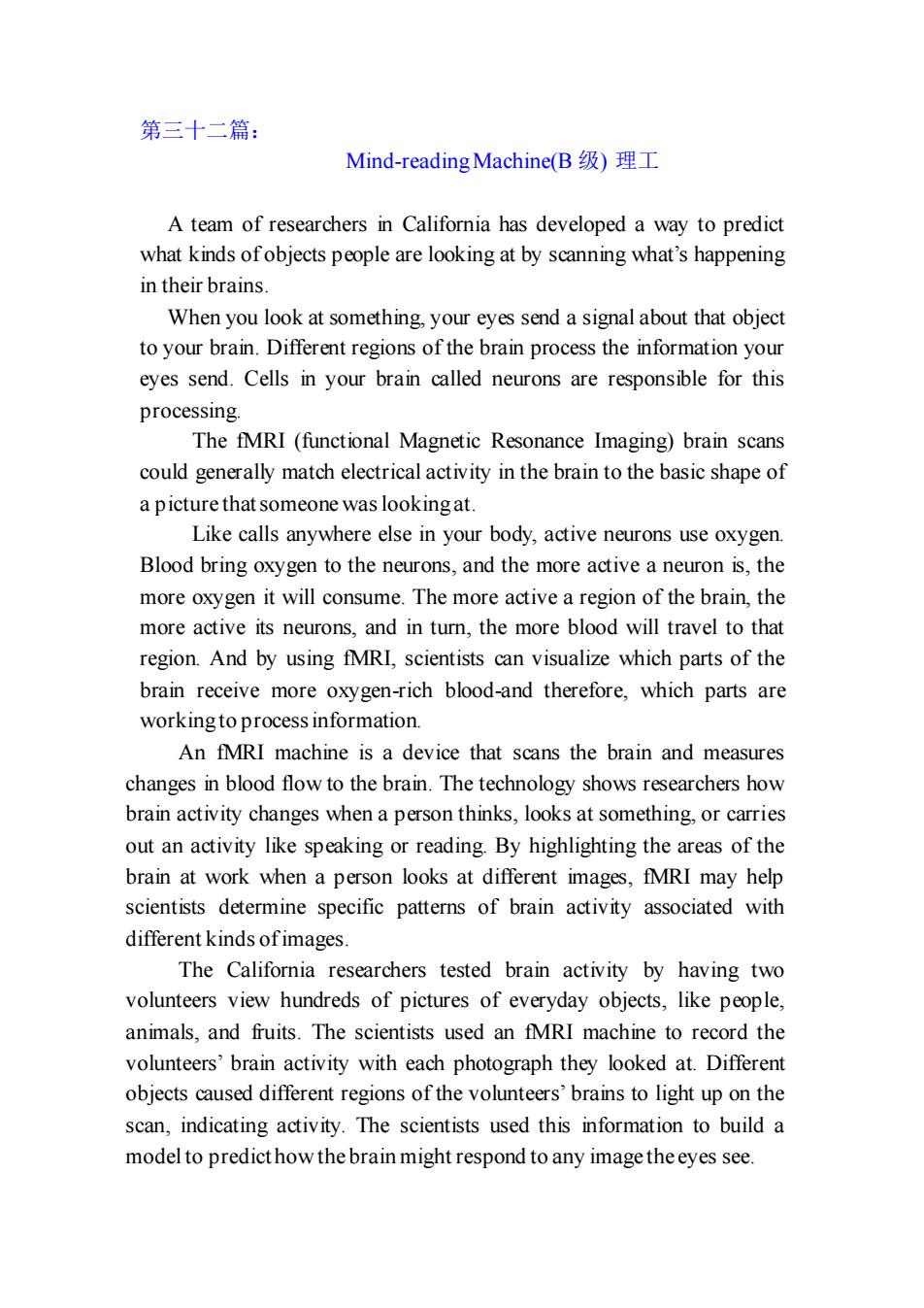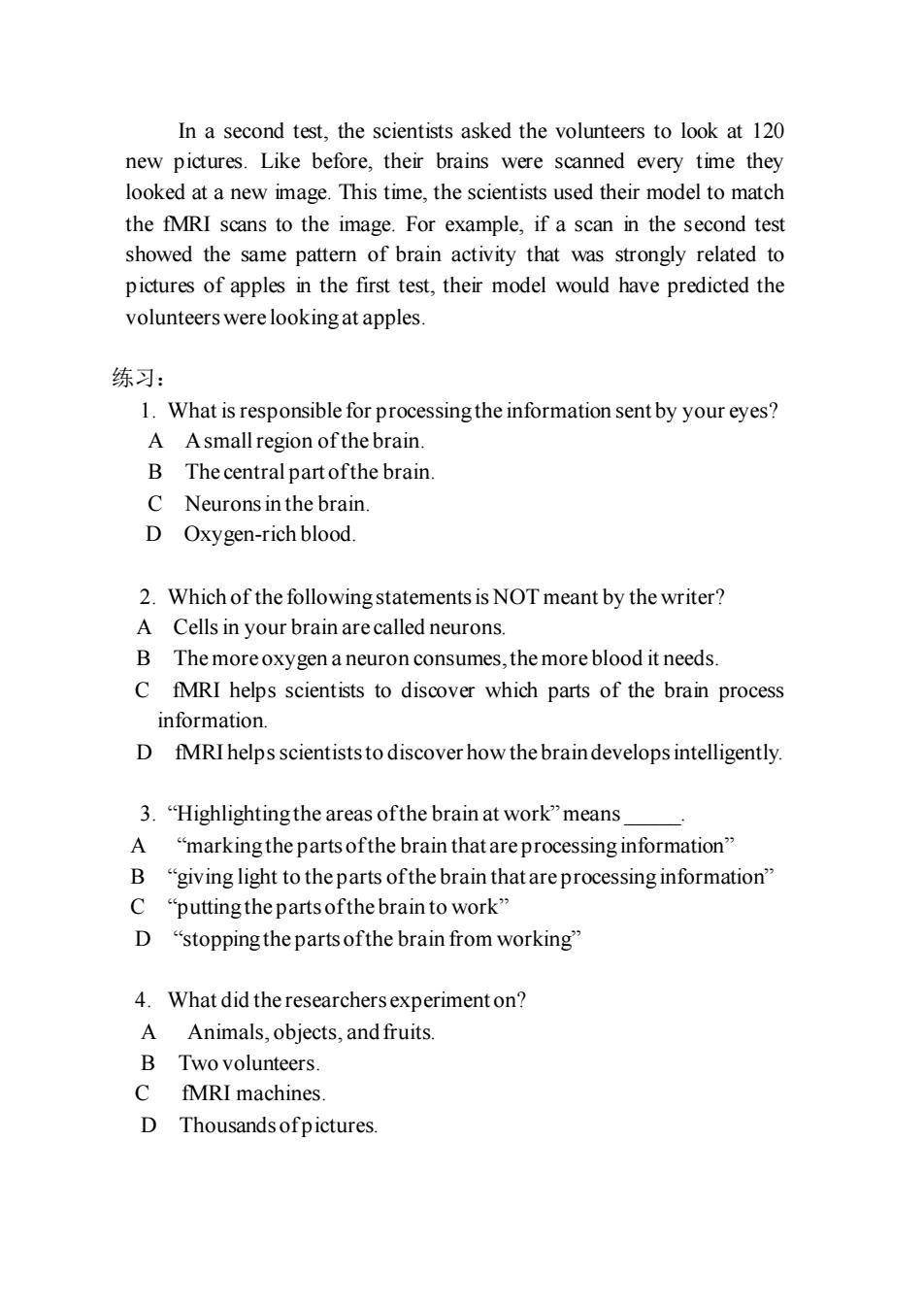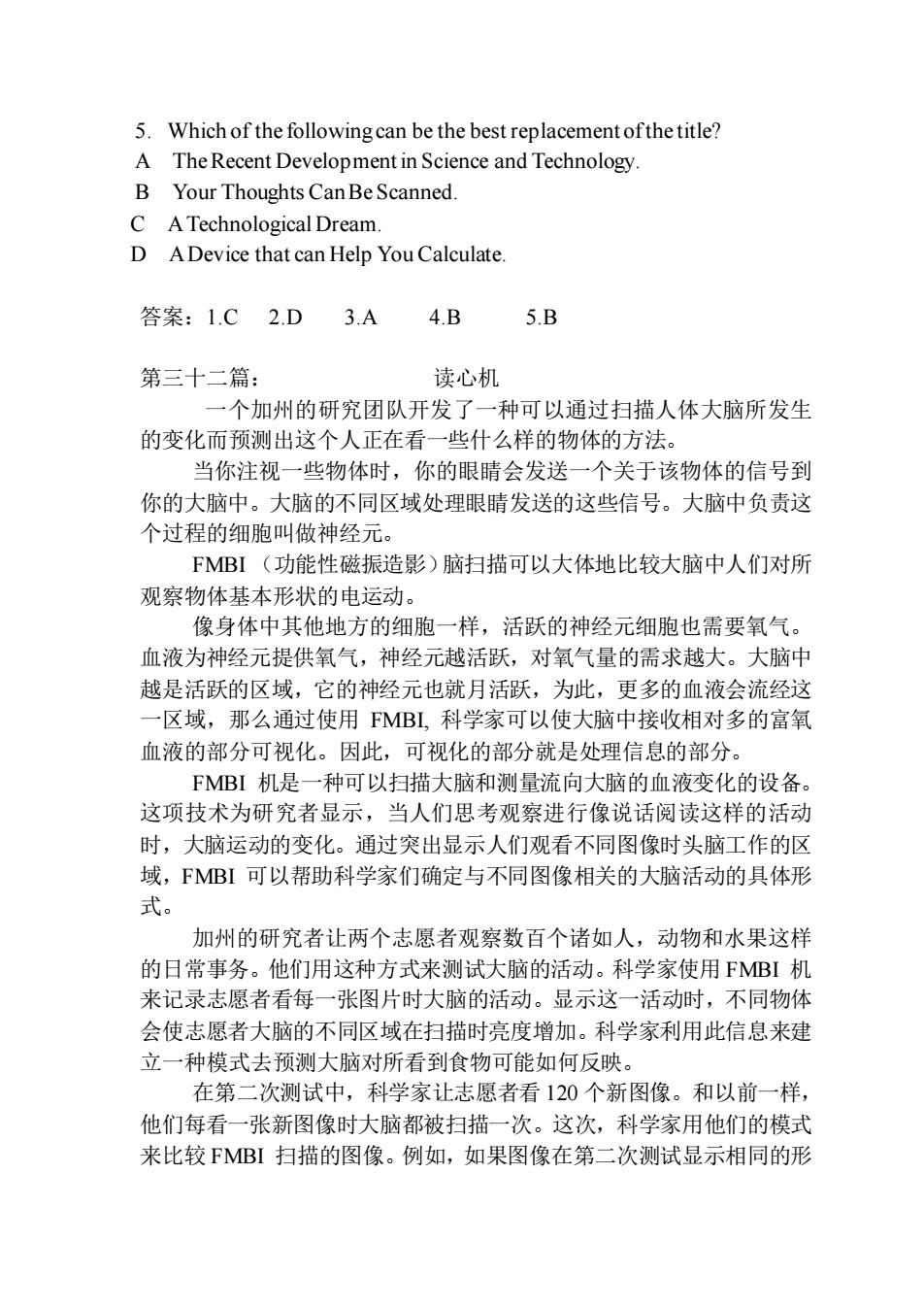
第三十二篇:Mind-readingMachine(B级)理工A team of researchers in California has developed a way to predictwhat kinds of objects people are looking at by scanning what's happeningintheirbrainsWhen you look at something, your eyes send a signal about that objectto your brain. Different regions of the brain process the information youreyes send. Cells in your brain called neurons are responsible for thisprocessingThe fMRI (functional Magnetic Resonance Imaging)brain scanscouldgenerallymatchelectricalactivityinthebraintothebasic shapeofa picture that someone was looking atLike calls anywhere else in your body, active neurons use oxygen.Blood bring oxygen to the neurons, and the more active a neuron is, themore oxygen it will consume. The more active a region of the brain, themore active its neurons, and in turn, the more blood will travel to thatregion. And by using fMRI, scientists can visualize which parts of thebrain receive more oxygen-rich blood-and therefore, which parts areworkingtoprocessinformation.An fMRI machine is a device that scans the brain and measureschanges in blood flow to the brain. The technology shows researchers howbrain activity changes when a person thinks,looksat something,or carriesout an activity like speaking or reading. By highlighting the areas of thebrain at work when a person looks at different images, fMRI may helpscientists determine specific patterns of brain activity associated withdifferentkindsofimagesThe California researchers tested brain activity by having twovolunteers view hundreds of pictures of everyday objects, like people,animals, and fruits. The scientists used an fMRI machine to record thevolunteers brain activity with each photograph they looked at. Differentobjects caused different regions of the volunteers' brains to light up on thescan, indicating activity. The scientists used this information to build amodel to predicthow the brain might respondto any imagetheeyes see
第三十二篇: Mind-reading Machine(B 级) 理工 A team of researchers in California has developed a way to predict what kinds of objects people are looking at by scanning what’s happening in their brains. When you look at something, your eyes send a signal about that object to your brain. Different regions of the brain process the information your eyes send. Cells in your brain called neurons are responsible for this processing. The fMRI (functional Magnetic Resonance Imaging) brain scans could generally match electrical activity in the brain to the basic shape of a picture that someone was looking at. Like calls anywhere else in your body, active neurons use oxygen. Blood bring oxygen to the neurons, and the more active a neuron is, the more oxygen it will consume. The more active a region of the brain, the more active its neurons, and in turn, the more blood will travel to that region. And by using fMRI, scientists can visualize which parts of the brain receive more oxygen-rich blood-and therefore, which parts are working to process information. An fMRI machine is a device that scans the brain and measures changes in blood flow to the brain. The technology shows researchers how brain activity changes when a person thinks, looks at something, or carries out an activity like speaking or reading. By highlighting the areas of the brain at work when a person looks at different images, fMRI may help scientists determine specific patterns of brain activity associated with different kinds of images. The California researchers tested brain activity by having two volunteers view hundreds of pictures of everyday objects, like people, animals, and fruits. The scientists used an fMRI machine to record the volunteers’ brain activity with each photograph they looked at. Different objects caused different regions of the volunteers’ brains to light up on the scan, indicating activity. The scientists used this information to build a model to predict how the brain might respond to any image the eyes see

In a second test, the scientists asked the volunteers to look at 120new pictures. Like before, their brains were scanned every time theylooked at a new image. This time, the scientists used their model to matchthe fMRI scans to the image. For example, if a scan in the second testshowed the same pattern of brain activity that was strongly related topictures of apples in the first test, their model would have predicted thevolunteers were looking at apples练习:1. What is responsible for processingthe information sent by your eyes?AAsmallregionofthebrain.B Thecentralpartofthebrain.CNeuronsinthebrainDOxygen-rich blood.2. Which of the following statements is NOT meant by the writer?ACells in your brain arecalled neurons.B The more oxygen a neuron consumes, the more blood it needs.CfMRI helps scientists to discover which parts of the brain processinformation.D fMRIhelps scientists to discover how the braindevelops intelligently3.“Highlightingthe areas ofthe brain at work"meansA“markingthe parts ofthe brain that are processing information"B “giving lighttothepartsofthebrainthatareprocessing information"C“puttingthepartsofthebraintowork"D“stoppingtheparts ofthebrainfrom working”4.Whatdidtheresearchersexperimenton?AAnimals,objects,andfruits.BTwo volunteers.cfMRI machines.DThousandsofpictures
In a second test, the scientists asked the volunteers to look at 120 new pictures. Like before, their brains were scanned every time they looked at a new image. This time, the scientists used their model to match the fMRI scans to the image. For example, if a scan in the second test showed the same pattern of brain activity that was strongly related to pictures of apples in the first test, their model would have predicted the volunteers were looking at apples. 练习: 1. What is responsible for processing the information sent by your eyes? A A small region of the brain. B The central part of the brain. C Neurons in the brain. D Oxygen-rich blood. 2. Which of the following statements is NOT meant by the writer? A Cells in your brain are called neurons. B The more oxygen a neuron consumes, the more blood it needs. C fMRI helps scientists to discover which parts of the brain process information. D fMRI helps scientists to discover how the brain develops intelligently. 3. “Highlighting the areas of the brain at work” means _. A “marking the parts of the brain that are processing information” B “giving light to the parts of the brain that are processing information” C “putting the parts of the brain to work” D “stopping the parts of the brain from working” 4. What did the researchers experiment on? A Animals, objects, and fruits. B Two volunteers. C fMRI machines. D Thousands of pictures

5.Which of the followingcan be the best replacement ofthe title?AThe Recent Development in Science and TechnologyBYourThoughtsCanBeScannedCA Technological Dream.DADevicethat canHelpYou Calculate答案:1.C2.D3.A4.B5.B读心机第三十二篇:一个加州的研究团队开发了一种可以通过扫描人体大脑所发生的变化而预测出这个人正在看一些什么样的物体的方法。当你注视一些物体时,你的眼晴会发送一个关于该物体的信号到你的大脑中。大脑的不同区域处理眼晴发送的这些信号。大脑中负责这个过程的细胞叫做神经元。FMBI(功能性磁振造影)脑扫描可以大体地比较大脑中人们对所观察物体基本形状的电运动。像身体中其他地方的细胞一样,活跃的神经元细胞也需要氧气。血液为神经元提供氧气,神经元越活跃,对氧气量的需求越大。大脑中越是活跃的区域,它的神经元也就月活跃,为此,更多的血液会流经这一区域,那么通过使用FMBI科学家可以使大脑中接收相对多的富氧血液的部分可视化。因此,可视化的部分就是处理信息的部分。FMBI机是一种可以扫描大脑和测量流向大脑的血液变化的设备。这项技术为研究者显示,当人们思考观察进行像说话阅读这样的活动时,大脑运动的变化。通过突出显示人们观看不同图像时头脑工作的区域,FMBI可以帮助科学家们确定与不同图像相关的大脑活动的具体形式。加州的研究者让两个志愿者观察数白个诸如人,动物和水果这样的日常事务。他们用这种方式来测试大脑的活动。科学家使用FMBI机来记录志愿者看每一张图片时大脑的活动。显示这一活动时,不同物体会使志愿者大脑的不同区域在扫描时亮度增加。科学家利用此信息来建立一种模式去预测大脑对所看到食物可能如何反映。在第二次测试中,科学家让志愿者看120个新图像。和以前一样,他们每看一张新图像时大脑都被扫描一次。这次,科学家用他们的模式来比较FMBI扫描的图像。例如,如果图像在第二次测试显示相同的形
5. Which of the following can be the best replacement of the title? A The Recent Development in Science and Technology. B Your Thoughts Can Be Scanned. C A Technological Dream. D A Device that can Help You Calculate. 答案:1.C 2.D 3.A 4.B 5.B 第三十二篇: 读心机 一个加州的研究团队开发了一种可以通过扫描人体大脑所发生 的变化而预测出这个人正在看一些什么样的物体的方法。 当你注视一些物体时,你的眼睛会发送一个关于该物体的信号到 你的大脑中。大脑的不同区域处理眼睛发送的这些信号。大脑中负责这 个过程的细胞叫做神经元。 FMBI (功能性磁振造影)脑扫描可以大体地比较大脑中人们对所 观察物体基本形状的电运动。 像身体中其他地方的细胞一样,活跃的神经元细胞也需要氧气。 血液为神经元提供氧气,神经元越活跃,对氧气量的需求越大。大脑中 越是活跃的区域,它的神经元也就月活跃,为此,更多的血液会流经这 一区域,那么通过使用 FMBI, 科学家可以使大脑中接收相对多的富氧 血液的部分可视化。因此,可视化的部分就是处理信息的部分。 FMBI 机是一种可以扫描大脑和测量流向大脑的血液变化的设备。 这项技术为研究者显示,当人们思考观察进行像说话阅读这样的活动 时,大脑运动的变化。通过突出显示人们观看不同图像时头脑工作的区 域,FMBI 可以帮助科学家们确定与不同图像相关的大脑活动的具体形 式。 加州的研究者让两个志愿者观察数百个诸如人,动物和水果这样 的日常事务。他们用这种方式来测试大脑的活动。科学家使用 FMBI 机 来记录志愿者看每一张图片时大脑的活动。显示这一活动时,不同物体 会使志愿者大脑的不同区域在扫描时亮度增加。科学家利用此信息来建 立一种模式去预测大脑对所看到食物可能如何反映。 在第二次测试中,科学家让志愿者看 120 个新图像。和以前一样, 他们每看一张新图像时大脑都被扫描一次。这次,科学家用他们的模式 来比较 FMBI 扫描的图像。例如,如果图像在第二次测试显示相同的形

式的大脑活动,同时,该脑活动与在第一次测试中苹果图片有大关联,那么这个模式可能会预测出志愿者们正在看一些苹果
式的大脑活动,同时,该脑活动与在第一次测试中苹果图片有大关联, 那么这个模式可能会预测出志愿者们正在看一些苹果